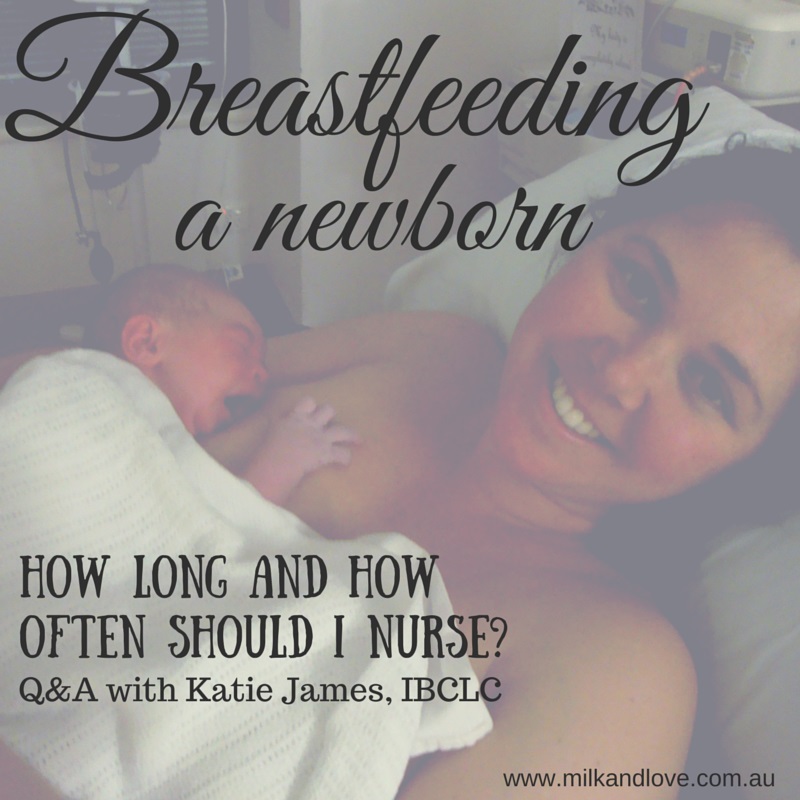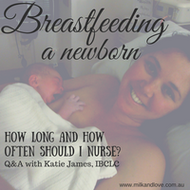How Often Should My Baby Breastfeed, and For How Long? Q&A with Katie James, IBCLC
Posted by Katie James, IBCLC and Midwife on Dec 07, 2014
Last week, we discussed Tandem Nursing a Toddler and Newborn, and we hope you enjoyed the video! Tonight Katie James, IBCLC and midwife answers Danika's great question "How Often Should My Baby Breastfeed and For How Long?"
Unfortunately, my webcam suffered a tech gremlin attack and didn't work, but Katie bravely soldiered on by herself and did a fabulous job! Thanks Katie!
If you have a topic you'd like us to cover, or someone you'd like us to interview, please contact us to let us know!
If you'd prefer to read, here is a summary of our discussion
How do we know when our babies have had enough to eat?
Firstly, noticing that once your milk has come in, around 60 to 80 hours after giving birth, you’ll find that the sucking pattern changes. Babies will tend to go straight onto the breast and start sucking quite quickly, and then you’ll notice that baby changes their sucking pattern to more suck swallow, suck, swallow, or suck, suck, swallow, suck, suck, swallow. You might even see or hear the swallows, baby might make an ahh, ahh sound. It’s a wonderful noise, when you first hear baby gulping. You can also look at the babies throat area, when babies sucking they’ll make quite quick jaw movements, and then they have a bit of a pause and a little bulge under their jaw when they swallow. Then over time, you’ll start to notice when your babies are having a swallow more easily.
You’ll also notice that when they’ve had enough they’ll pull off themselves, or they’ll release the nipple or breast, and be very relaxed and sleepy. They’ll often feed for a certain amount of time on one breast and look really sleepy, but if you put the baby down for a sleep then they might only sleep for half an hour or 45 minutes then wake up… “aha I wasn’t finished!”.
Most babies when you see those early feeding cues, hands going, tongue poking, turning their face to whatever touches them, sucking their fists, that’s them saying “I’m ready to feed”. Pop them on the breast and feed them, when they pull off themselves and look satisfied you can go and change their nappy to gently stimulate them and awaken them and you’ll probably find you get those feeding cues again, and this would be the time to try baby on the next breast. Some babies will happily go on for another feed, and others will be full, but because you’ve woken them you’ll know, and hopefully when you put them down for a sleep they’ll sleep for longer.
What if my baby just nurses and nurses all the time?
If they’re continuously feeding day and night, then there may be an attachment problem, baby isn’t attached deeply enough onto the breast and baby isn’t able to drain the milk efficiently. What happens is often if babies are shallowly attached, and only sucking on the end of the nipple, the milk doesn’t come out as efficiently. Instead of going suck, swallow, suck, swallow, the baby is going suck, suck, suck, suck, swallow. This is hard work. So the babies jaw gets tired, the baby gets tired, and falls asleep at the breast. When you wake the baby up the baby wants to keep feeding. They’re never really full enough. What we’re aiming for is that the baby is attached really deeply to the breast and is able to drain the milk efficiently from the breast. If you’re finding this to be an issue, I would recommend going to see a lactation consultant to have your attachment checked out.
What do we consider to be nursing all the time?
We know that birth to 6 months, babies feed roughly between 8 – 12 times every 24 hours. This can be really surprising to most new mums because it seems to be all the time. If you think back over the last 24 hours think about how often you had a glass of water, a snack, a cup of tea, a biscuit and your main meals. Most of us are probably eating or drinking around 6 times a day, and we’re not actively trying to gain weight. In the first 6 months, your baby is trying to double her birth weight or more. So they need to feed this frequently.
Should you start recording information?
There are so many apps out there to help record information about feeding, nappy changes etc, but sometimes technology makes this natural process too confusing. I’m a list person, I like to keep lists of things, jot them down and that really helps for the first couple of days or weeks. Creating lists beyond that can take your focus away from being with your baby and your instincts. Women have been able to know for centuries and centuries when their baby is hungry, when they’ve had enough and which breast to nurse from, and how often. That comes as an instinct over the first 6 to 8 weeks when everything starts to settle down and you really start to understand your relationship with your baby. It does take time. So should you record information? Yes, if it’s helpful. Yes, if your baby has lost more than 10% of his birth weight, yes if you’ve been having some breastfeeding problems, or baby has had some weight gain problems. Sometimes having a record when you’re so exhausted in the first couple of days or weeks, can be really helpful. You probably want to record what time baby fed, how many wet nappies and the colour of the poo. You might want to record how long baby has breastfed for. But if baby is well attached and nursing for over 10 minutes then most babies are having a good feed.
What is the average nursing time on each breast?
The average feed varies from woman to woman depending on how quickly her milk flows, and how much milk she holds in each breast. That’s why there is no prescription on how long you should feed for, or how long on each breast. In years gone by, you would hear the midwife saying you have to feed x minutes per side. We now know that each individual baby, and each individual breast will need different amounts of time depending on how the milk flows, so watch your baby and listen to your baby. If your baby attaches well and comes off looking satisfied, and is otherwise doing lots of wet nappies and yellow poos, and seems content and is gaining weight each week, you’re doing a marvellous job. If some of those signs don’t fit, then always go and check it out and have your baby weighed, and have your breastfeeding looked at by a health professional who can tell you when the baby is swallowing, how often you need to feed, and look at whether your baby needs one breast or maybe two sides.
Thanks very much for listening. Next week we’ll be discussing Breastfeeding as Your Baby Develops. Please join us, or send in any questions you have!
We’d love to hear from you, if you have any feedback or would like to suggest a topic, please contact us and let us know!


